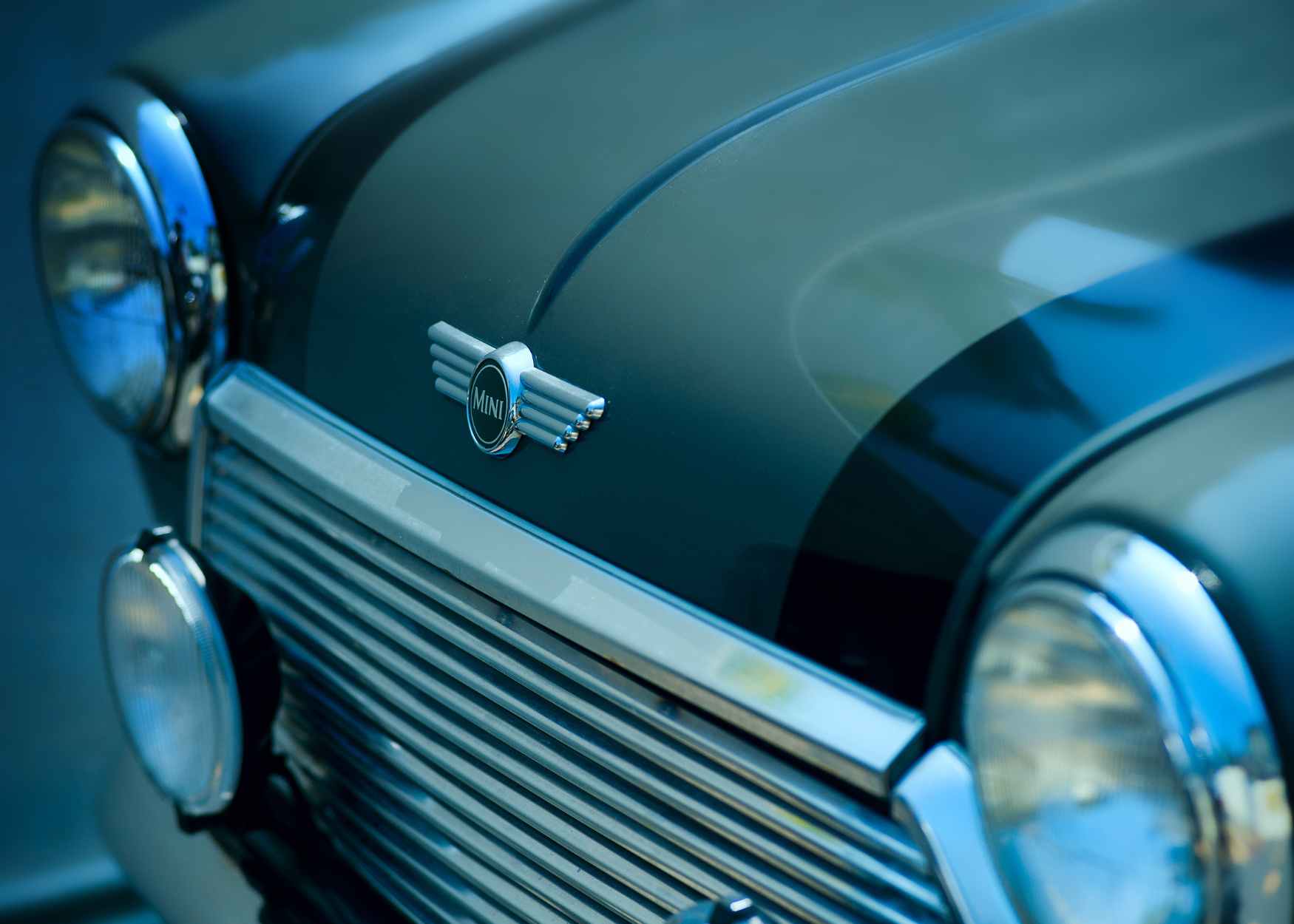
The allure of classic cars in cinema extends beyond their sleek designs and roaring engines. These vehicles often become characters in their own right, etching their mark in cinematic history. Here the team at White's Bodyworks look at six iconic UK movie vehicles, exploring their roles in landmark films and their enduring legacy.
If you own a classic car, check out our full list of restoration and repair services in West Sussex.
Film Overview: "The Italian Job" is a British caper film that became famous for its audacious gold heist plot, witty dialogue, and groundbreaking car chase scenes. Directed by Peter Collinson, it stars Michael Caine, Noël Coward, and Benny Hill.
The Car: The Mini Cooper, a symbol of British culture in the 1960s, plays a pivotal role in the film's climax. These small but agile cars, painted in red, white, and blue, zip through the streets of Turin, Italy, showcasing remarkable stunts and manoeuvres. Their compact size and nimbleness were perfectly suited to the film's daring urban chase sequences, solidifying the Mini's iconic status in pop culture.
Film Overview: "Goldfinger" and "Thunderball" are part of the James Bond series, starring Sean Connery as the suave spy. "Goldfinger," directed by Guy Hamilton, revolves around Bond's mission to stop a gold magnate's sinister plan. "Thunderball," directed by Terence Young, sees Bond in a race to recover stolen nuclear warheads.
The Car: The Aston Martin DB5, introduced in "Goldfinger" and reprised in "Thunderball," became synonymous with James Bond. Equipped with gadgets like ejector seats, machine guns, and a bullet-proof shield, the DB5 encapsulated the high-tech, luxurious world of Bond. This car not only set a standard for Bond's vehicles but also became an emblem of British sophistication and style in the automotive world.
Film Overview: This musical adventure film, directed by Ken Hughes and based on a novel by Ian Fleming, is a whimsical tale centred around an eccentric inventor, played by Dick Van Dyke. The story unfolds as he creates a magical car that flies and sails.
The Car: Chitty Chitty Bang Bang, the titular car, is a custom-built Edwardian racing car. This enchanting vehicle with its unique design and ability to 'fly' captured the hearts of audiences, especially children. The car was a blend of fantasy and reality, showcasing early 20th-century automotive design while embodying a fairy-tale-like charm.
Film Overview: "Get Carter," directed by Mike Hodges, is a gritty crime film featuring Michael Caine as Jack Carter, a London gangster who returns to his hometown to investigate his brother's mysterious death. The film is known for its dark tone and realistic portrayal of the criminal underworld.
The Car: The Austin A50 Cambridge used in "Get Carter" reflects the film's setting in the industrial North of England. The A50, a typical British family car of the 1950s, is unassuming yet dependable. Its presence in the film adds an element of authenticity and contrasts sharply with the glitz often associated with crime and gangster movies.
Film Overview: Another entry from the James Bond series, "The Spy Who Loved Me," directed by Lewis Gilbert, features Roger Moore as Bond. The plot involves Bond teaming up with a Soviet agent to stop a megalomaniac from destroying the world.
The Car: The Lotus Esprit S1 in this film is celebrated for its futuristic design and incredible transformation into a submarine. The sleek, white sports car exemplifies 1970s automotive design and remains one of the most memorable Bond cars for its versatility and the awe-inspiring transformation scene.
Film Overview: Directed by Doug Liman, "The Bourne Identity" is a fast-paced action thriller starring Matt Damon as Jason Bourne, a CIA assassin suffering from amnesia. The film revitalizes the spy genre with its intense action sequences and complex plot.
The Car: The Mini Mayfair MkV plays a significant role in one of the film's high-octane chase scenes through the narrow streets of Paris. The choice of a modest, unassuming Mini for such a pivotal scene added a touch of realism and grounded the film's otherwise over-the-top action, demonstrating that in skilled hands, even the most ordinary vehicle can become extraordinary.
These six classic UK cars have not only left a mark on the films they appeared in but have also influenced our culture and the way we view cars in the context of storytelling. Each vehicle, from the agile Mini Cooper in "The Italian Job" to the sophisticated Aston Martin DB5 in the James Bond films, offers more than just a mode of transport; they contribute to the narrative, character development, and the overall aesthetic of their respective films.
In "Chitty Chitty Bang Bang," the car is essentially a character in its own right, a whimsical creation that brings magic and adventure to the story. The Austin A50 in "Get Carter," on the other hand, provides a stark contrast to the flashy cars typically associated with gangster films, reflecting the film's gritty realism.
The Lotus Esprit S1 from "The Spy Who Loved Me" represents the pinnacle of 1970s automotive design and technological aspiration, serving as a symbol of the era's fascination with futuristic concepts. Meanwhile, the Mini Mayfair MkV in "The Bourne Identity" demonstrates that even a small, unassuming car can play a central role in a high-stakes action sequence, bringing a unique blend of practicality and charm to the film.
These iconic vehicles have transcended their roles in cinema to become cultural icons, representing a blend of British engineering, style, and innovation. They not only capture the essence of their respective eras but also continue to inspire car enthusiasts and filmmakers alike. The enduring appeal of these classic cars lies in their ability to connect with audiences, offering a tangible link to the fantasy and glamour of the movies they grace.
The relationship between classic cars and cinema is one of mutual enhancement. Cars like the Mini Cooper, Aston Martin DB5, and Lotus Esprit S1 have become much more than props; they are integral to the storytelling process, adding depth, excitement, and a sense of identity to the films they appear in. Their legacy in cinema is a testament to the enduring connection between the art of filmmaking and the world of automotive design, a relationship that continues to captivate and fascinate audiences around the world.



